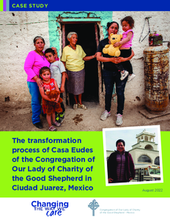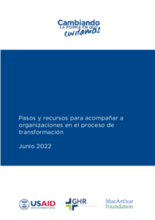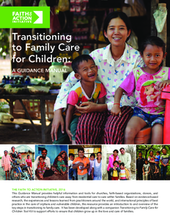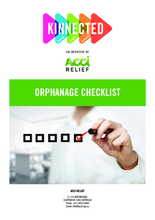What would transition look like for the organisation and based on their context
After looking at the big picture of care reforms, the next step is to zoom in and explore the implications of what transitioning to family care means in context for the individual organisation and their services. Context could include:
- The national context (national laws, policies, government plans),
- The organizational context (vision, mission, stakeholders, history, motivations and partnerships); and
- The local context (cultural and socio-economic)
- The beneficiary context (the situation of children and families the organisation supports)
The aim of this stage is therefore to consider and work through the realities for transitioning to family-based care for the specific organization and reach the point where an in-principle initial decision to progress with a transition can be made by the key decision makers within the organization.
This step is focused on exploration of context and deliberation. Key actions could include:
- Targeted research and learning about the status of child protection and care reforms in the country (national policies, action plans, commitments to care reforms)
- Trainings or workshops
- Discussions and reflections on the organization’s vision/mission/purpose and methodology
- Discussions, Q & As, forums where key decision makers can raise and discuss challenges/concerns
- Reviewing relevant examples of practice from other organizations (from the same country or relevant countries/cultures/contexts) who have undergone transition or who run programs that are viable alternatives to residential care.
- Engaging in or supporting internal advocacy/awareness raising to expand discussions to bring key decision makers on the journey. This may include board presentations or trainings, meetings with key donors, or other staff in key leadership roles.
- Negotiating a preliminary in principle commitment among key stakeholders/decision makers to transition
- Ensuring there is clarity around the high-level objectives of transition and most significant implications for the organisation. This helps create alignment and minimizes future misunderstanding, ensuring key decision makers are all on the same page.
- For those supporting the transition of another organisation, not their own, this is likely to be the time to make an initial visit to the residential care centre to understand the situation of the organization and the residential care service they run.
Topics or issues that may need to be explored and discussed throughout this step include:
- The national context and status of national child protection and care reforms (e.g., government commitments and current laws)
- Short-and long-term implications for the organisation and their services
- The common causes of separation and reasons for admission of children into the residential care facility and current situation of their families (in general terms)
- Existing alternative services and solutions to address the needs of children and families focusing on addressing root causes.
- Differences between rights-based and charitable approaches to programming (including how programs can either contribute to the progressive realization of children’s rights or create conflicts and cause rights regressions)
- What transitioning entails (key elements, phases, timeframes, processes and setting realistic expectations)
- Preliminary questions and concerns regarding transition (overcoming barriers, finding solutions and debunking myths)
- Preliminary cost modelling/projections (forecasting the cost of transition which may be important to get board level agreements to progress)
- Preliminary agreement to progress with transition
- Determination of the key commitments each stakeholder is making throughout the transition and the terms all decision making stakeholders agree to abide by (this is based on their specific roles i.e as a donor, director, board member etc)
The key milestones associated with this step are, the organizations key decision makers have:
- An understanding of the local impetus for change, including the direction the government is moving towards with child protection and care reforms.
- General recognition of the merits of transition in the local context despite acknowledging some of the challenges.
- An in-principal commitment to proceed with transition or more in-depth exploration of transition and progress to the next stages of exploration and planning.
Resources
Displaying 11 - 18 of 18
This case study highlights the transition of the Sisters of Our Lady of Charity of the Good Shepherd in Ciudad Juarez. It is an honest look at the emotional, logistical, and practical elements involved in transitioning from a residential care model which existed for more than 100 years to a provider of community-based and family-centered services.
Este documento está diseñado para orientar a las personas u organizaciones que están apoyando un proceso de transición para pasar de proporcionar atención residencial a un modelo que promueva la atención familiar y comunitaria. El documento está diseñado en torno a las Fases de la Transición de Better Care Network. Se basa en el trabajo que Changing the Way We Care ha realizado en los últimos años para apoyar a diferentes proveedores de atención residencial, tanto religiosos como laicos, en su propio proceso de transición. Hay ejemplos y enlaces a herramientas relevantes, mensajes y actividades sugeridas que pueden utilizarse para apoyar las diferentes fases del proceso.
In this video Simon Kanyembo, Director of Social Services at ACE Zambia, addresses the following questions: why child welfare organizations should prefer family-based care to institutional care and response to children who are abandoned or unable to be reintegrated.
In this video Chilala Shilimi Nyendwa, Manager of the Family Preservation and Empowerment Program for ACE Zambia, addresses the following questions: social stigma facing reintegrated children; ability of families to financially support their children and how organizations might respond when families cannot; and child safety outside of institutional care.
In this video Daisy Muzukutwa, Executive Director of ACE Zambia, addresses the following questions: financial viability of reintegration; future of institutional staff after the transition; and where to begin when considering a transition.
Transitioning to Family Care for Children: A Guidance Manual aims to provide practical guidance and tools for churches, faith-based organizations, donors, and others who are transitioning care for children away from residential care to care within families.
This video documents how a child protection model from Malawi works as part of the Integrated (HIV Effect) Mitigation and Positive Action for Community Transformation (IMPACT) program.
This checklist was developed by Kinnected, an initiative of ACCI Relief in Australia, to guide donors and supporters of orphanages in understanding how the orphanages they support are being run and how well they are aligning with best practices.




